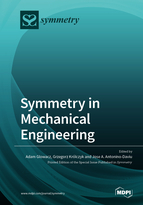Symmetry in Mechanical Engineering
A special issue of Symmetry (ISSN 2073-8994). This special issue belongs to the section "Computer".
Deadline for manuscript submissions: closed (30 November 2019) | Viewed by 66914
Special Issue Editors
Interests: machine; fault diagnosis; pattern recognition; IoT; signal processing; signal analysis; image processing; computer science; automatic
Special Issues, Collections and Topics in MDPI journals
Interests: fault diagnosis; vibration analysis; measurement; materials
Special Issues, Collections and Topics in MDPI journals
Interests: fault diagnosis; vibration analysis; measurement; mechanical engineering; diesel engines
Special Issues, Collections and Topics in MDPI journals
Interests: electric motors; fault diagnosis; transient analysis; signal processing; wavelet analysis; infrared thermography; time-frequency transforms
Special Issues, Collections and Topics in MDPI journals
Special Issue Information
Dear Colleagues,
This Special Issue invites original research papers that report on the state-of-the-art and recent advancements in mechanical engineering: measurement, fault diagnosis, construction, operation and maintenance of machines, vibration, noise, smart-material systems, integrated systems, stresses, deformations, mechanical properties, signal processing of mechanical systems, fault diagnosis of machines, shafts, springs, belts, bearings, gears, rotors, rotor dynamics, and machine elements. This Special Issue encompasses applications in mechanical engineering, modelling methods for rigid-body mechanics, structural mechanics, impact mechanics, strain localization, tribology, and thermodynamics. Review articles related to mechanical engineering are also encouraged.
Prof. Dr. Adam Glowacz
Prof. Dr. Grzegorz Krolczyk
Prof. Dr. Zhixiong Li
Prof. Dr. Jose Alfonso Antonino Daviu
Guest Editors
Manuscript Submission Information
Manuscripts should be submitted online at www.mdpi.com by registering and logging in to this website. Once you are registered, click here to go to the submission form. Manuscripts can be submitted until the deadline. All submissions that pass pre-check are peer-reviewed. Accepted papers will be published continuously in the journal (as soon as accepted) and will be listed together on the special issue website. Research articles, review articles as well as short communications are invited. For planned papers, a title and short abstract (about 100 words) can be sent to the Editorial Office for announcement on this website.
Submitted manuscripts should not have been published previously, nor be under consideration for publication elsewhere (except conference proceedings papers). All manuscripts are thoroughly refereed through a single-blind peer-review process. A guide for authors and other relevant information for submission of manuscripts is available on the Instructions for Authors page. Symmetry is an international peer-reviewed open access monthly journal published by MDPI.
Please visit the Instructions for Authors page before submitting a manuscript. The Article Processing Charge (APC) for publication in this open access journal is 2400 CHF (Swiss Francs). Submitted papers should be well formatted and use good English. Authors may use MDPI's English editing service prior to publication or during author revisions.
Keywords
- deformation
- stresses
- mechanical properties
- tribology
- thermodynamic
- measurement
- fault diagnosis
- machine








